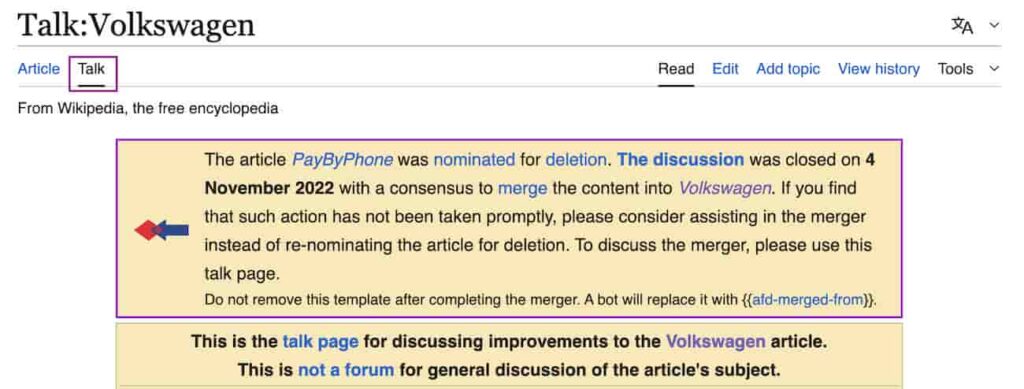How to Protect Your Wikipedia Page from Deletion or Vandalism
Wikipedia pages for companies sometimes show abnormal edits alongside incorrect facts and alert notifications for removal. It’s a frustrating situation that requires Wikipedia page protection. The proper representation of your organization through extensive Wikipedia page development becomes useless when vandalism and false information start to corrupt your content.
Companies can achieve excellent Wikipedia page credibility with proper maintenance. All of Wikipedia operates under defined rules, along with community-established expectations and specific guidelines. Knowledge of common issues, such as notability disputes, malicious edits, and insufficient sourcing, helps you develop protective measures for your content.
The following article explains Wikipedia Article Deletion & Maintenance, which we cover in even greater detail in The Guide to Wikipedia Article Deletion & Maintenance. Our practical guide shows you how to stop deletion and vandalism of your page while using proven methods that build a trusted digital presence.
Key Takeaways
- Understand Wikipedia’s rules: Familiarity with guidelines, including notability, neutrality, and reliable sourcing, helps your page succeed and withstand criticism.
- Active monitoring of the Watchlist feature serves as your frontline defense against vandalism by identifying potential accuracy threats.
- Productive engagement with Wikipedia’s editor community works best when you maintain respectful collaboration practices.
A well-managed Wikipedia page requires both knowledge of its environment and proactive defense systems, instead of waiting to respond to issues. The following section explains the specific methods to protect your Wikipedia page.
Understanding Wikipedia Page Deletion and Vandalism
If your Wikipedia page is vandalized, flagged, or deleted, the consequences can be immediate and far-reaching for your online reputation. That’s because Wikipedia dominates search visibility: it appears on the first page of Google results in over 50% of all searches, and ranks in the top three results for more than 33% of them.
Yet despite its prominence, Wikipedia is an unforgiving platform. Every day, between 1,000 and 1,500 articles are deleted, often within minutes or hours of being created. With more than 6.7 million articles in the English edition, you’d think yours would be safe — but less than 0.01% of all potential topics survive Wikipedia’s rigorous notability and sourcing standards without significant revision or risk of removal.
In other words, losing your Wikipedia page isn’t just a content issue — it’s a high-impact reputational event that can make authoritative information about you vanish from search results overnight.
Common Reasons for Wikipedia Page Deletion
The delivery of unbiased, dependable information on Wikipedia depends on the platform’s strict guidelines. Wikipedia removes pages that fail to meet its established guidelines.
The primary reason Wikipedia removes pages from its database is that they lack notability. An organization should seek extensive coverage from respected external publications, including major news outlets and industry journals, rather than relying solely on internal resources. The Wall Street Journal provides stronger credibility than your company’s blog content.
A major issue with Wikipedia pages is weak or absent source references. Each page requires documented, credible sources. Your content will face editorial challenges when the page heavily depends on self-published materials and press releases.
Editorial templates appear on your page after an editor detects excessive reliance on primary sources, which can be difficult to remove. The page becomes eligible for deletion as a result.

Promotional language usage on a page will trigger warning signals. Wikipedia exists to deliver educational information, not promotional materials. The use of marketing terms and biased statements makes pages vulnerable to inspection by Wikipedia editors.

The risk of page deletion exists when a Wikipedia page has duplicate content. A page deletion risk arises when two companies share the same brand but the subsidiary lacks unique content that distinguishes it from the main brand. This puts the subsidiary page at risk of potential deletion or consolidation.
Common Forms of Wikipedia Vandalism
The open Wikipedia platform exposes pages to various forms of vandalism. Vandalism tactics include purposeful entry of false or misleading content, which damages credibility. Your company needs immediate action to detect and reverse any vandalism that competitors use to misrepresent your financial situation during controversies.
The practice of page blanking involves the sudden removal of all content, leading to immediate damage to your brand reputation and customer confusion. Your brand reputation might suffer if your visitors encounter offensive or irrelevant content on your page first.
For example, a retail brand faced vandalism stemming from repeated false accusations during a product recall crisis. The proactive monitoring approach discussed later helped protect their page’s credibility.
How to Prevent Wikipedia Page Deletion
Adhere to Wikipedia’s Content Guidelines
Wikipedia page protection can be achieved by following Wikipedia’s policies on notability, neutrality, and reliable citations.
Ensure your organization is clearly notable by having quality third-party mentions from reputable sources or authoritative industry analysis. A Harvard Business Review article that references your innovation will significantly increase your credibility.
Keep your writing factual and unbiased. Instead of “Company X revolutionized healthcare,” state something that has independent analysis, such as: “In 2022, Company X launched its patented AI healthcare tool, recognized by the Mayo Clinic and Medical Review Journal.”
One of the most effective ways to protect a Wikipedia page from deletion is by grounding it in high-quality, independent, and verifiable sources. Wikipedia’s notability guidelines require significant coverage in reliable publications that are not affiliated with the subject. Sources must be secondary, meaning they provide analysis or commentary — not just reprint what your company or spokesperson says.
Many pages get flagged or deleted simply because they rely too heavily on press releases, personal blogs, or company websites, which are considered biased or promotional.
Use this guide to evaluate your citations:
| ✅ Good Source | ❌ Bad Source |
|---|---|
| The Guardian | Company blog |
| Wired Magazine | LinkedIn profile |
| Peer-reviewed article | Press release |
To keep your article safe, think like a journalist: cite outlets and journals that would pass a newsroom’s editorial standards. If in doubt, ask whether a Wikipedia editor with no connection to you would consider the source neutral and trustworthy.
Audit Wikipedia Page
Regular audits help ensure that the page complies with the required standards and that the content is up to date. The “View History” tab displays the full edit history of your page, including usernames and timestamps. The feature allows you to identify problematic contributors and questionable edits.

The Watchlist tool on Wikipedia allows you to monitor pages that have active changes. Your notifications should be checked regularly so you can catch potentially harmful edits as they happen in real time, rather than discovering them after several months.
The standard procedure should be quarterly reviews for handling management changes, product launches, and other newsworthy events. Active management practices combined with frequent updates help protect your page from deletion flags.
Engage with Wikipedia’s Editor Community
Respectful interaction with Wikipedia editors helps to build goodwill and reduce the risk of deletion. Content issues can be addressed by using the article’s “Talk” page to start constructive discussions to clarify misunderstandings and provide neutral, verifiable answers to feedback.

If an editor raises doubts about notability or neutrality, you should present credible third-party evidence while working with the editor to comply with established guidelines.
Transparency, coupled with politeness and openness, helps build trust with editors and safeguards your page from future problems.
How to Protect Your Wikipedia Page from Vandalism
Set Up and Monitor a Watchlist
The Watchlist tool is your best way to prevent unwanted modifications. The system operates as an early warning system, sending you notifications of any changes to your content.
To create your Watchlist, you need to be logged in to your Wikipedia account. Click the star icon on your page’s top right corner. When you star your page, the star icon turns blue to show that you are now tracking your page. You can adjust the Watchlist settings to remove minor edits and to get email notifications for immediate alerts.
The combination of Watchlist monitoring and “View History” analysis helps detect recurring negative edits from specific contributors, which enables prompt intervention.
Example: Handling Brand Vandalism
Suppose your financial services firm has incorrect allegations about insider trading. With an active Watchlist, you’re notified right away, revert the edit, verify correct details publicly, and clearly record the issue to alert Wikipedia admins if it recurs. The quicker you can intervene, the lower the risk that unchecked misinformation can harm your credibility.
Working with dependable Wikipedia editors and getting administrative assistance helps protect your page from continuous or severe vandalism, which ensures long-term protection.
Utilizing Reputation X Expertise for Wikipedia Page Management
How Reputation X Can Support Your Page
Our monitoring service goes beyond standard Watchlist features through dedicated, round-the-clock observation. Reputation X ensures quick issue resolution for brands that encounter regular misrepresentations or challenging edits and busy brands that might not have the time to handle these issues.
We serve as effective mediators between clients and Wikipedia editors to resolve disputes efficiently. Our diplomatic approach works to solve problems methodically, which stabilizes your online presence.
Ethical Practices and Long-Term Solutions
Reputation X uses ethical practices alongside long-term strategies to protect Wikipedia pages. Semi-protection serves as an alternative solution for persistent vandalism by restricting editing permissions to authenticated and verified contributors. Our team assists you with detailed vandalism documentation to request protection through a method that provides enduring solutions beyond the short term.
We teach our clients about Wikipedia standards so they can maintain their pages properly. The team provides immediate help with implementing reliability-enhancing content updates together with collaboration practices. Your Wikipedia visibility and brand image will improve through our ethical, transparent operations.
Key Steps to Ensure Page Longevity
Proactive Maintenance to Avoid Deletion Risks
The Talk page requires your constant monitoring to track all active discussions. Address editor concerns about neutrality and sourcing through strong evidence from reputable third-party sources.
Organizations must exercise extra caution during periods of increased media attention to protect both accuracy and neutrality.
Creating a Vandalism-Proof Strategy
The combination of Watchlist monitoring and community relations is an effective way to prevent vandalism through effective problem management.
Teach your communications team about Wikipedia guidelines to improve their response capabilities. You need to address ongoing vandalism issues by contacting administrators or working with reputation management experts who can help.
An effective defense strategy against attacks and disruptions requires active monitoring, genuine community engagement, and clear communication.
Conclusion
A successful Wikipedia page protection requires ongoing attention, along with responsive actions and active involvement. The Wikipedia content needs to present unambiguous facts that remain accurate because they are backed by a reliable source.
Your brand values must align with Wikipedia’s open and cooperative principles. A Wikipedia page managed by experts establishes credibility that extends past the platform to create a stronger reputation among customers as well as partners and employees.
The ethical management of your Wikipedia content protects your online narrative and enhances your brand reputation on digital platforms.
Tags: Wikipedia.
